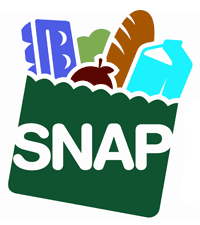SNAP to Health!
December 2, 2011 Hunger and food insecurity are major public health problems in America that have escalated dramatically in response to the current economic recession. The Supplemental Nutrition Assistance Program (SNAP), formerly the Food Stamp Program, serves as the U.S. Department of Agriculture’s largest food assistance program, and provides a safety net for the nation’s low-income population to meet food and nutrition needs. The program aims to alleviate hunger and improve nutrition by increasing the resources available to low-income households and individuals to purchase food.
Hunger and food insecurity are major public health problems in America that have escalated dramatically in response to the current economic recession. The Supplemental Nutrition Assistance Program (SNAP), formerly the Food Stamp Program, serves as the U.S. Department of Agriculture’s largest food assistance program, and provides a safety net for the nation’s low-income population to meet food and nutrition needs. The program aims to alleviate hunger and improve nutrition by increasing the resources available to low-income households and individuals to purchase food.
This year, SNAP participation is at its highest level since the program’s inception. A record 45.8 million people in the United States (roughly 15 percent of the U.S. population) are currently enrolled in SNAP, a 38 percent increase since 2008. Nearly 50 percent of those beneficiaries are children.
Since 1939 when SNAP was established in 1939 to address food insecurity, there has been a dramatic rise in obesity in the U.S. – 68 percent of Americans are overweight or obese. This is a particular problem for low-income populations. Though SNAP has been helpful in alleviating hunger, the program has made little use of its purchasing power to encourage participants to purchase high-nutrient foods such as fruits and vegetables, lean meats and whole grains that could promote health and prevent obesity. Under current SNAP regulations, there are virtually no restrictions on what foods can be purchased nor are there incentives to purchase healthy foods.
At the federal level, the legislation with the greatest impact on SNAP and the U.S. food supply is the Farm Bill, which will be reauthorized in 2012. It offers a significant opportunity to align farm and food policy with national public health priorities and to reformulate SNAP as a program that serves not only as an invaluable safety net to low-income households but also as a tool in the fight against the concurrent threats of food insecurity and obesity in this population.
Promising strategies to achieve this goal have been proposed, including incentives for purchasing nutritious food, disincentives for buying certain products, improving the inventory stocked by SNAP-approved retailers, as well as harnessing information technology to enhance nutrition education and program implementation.
Until today, there has not been a place where interested individuals across multiple sectors could convene to discuss ideas of how to improve nutrition among SNAP beneficiaries. Launched today, the SNAP to Health website aims to do just that– provide a centralized venue for this discussion.
This innovative “virtual town hall” for dialogue about SNAP and nutrition, is part of a project spearheaded by the Center for the Study of the Presidency and Congress (CSPC), a non-profit, non-partisan policy organization dedicated to generating innovative solutions for the nation’s current challenges.
SNAP to Health is an initiative that seeks to put health and nutrition at the forefront of discussions guiding the 2012 re-authorization of SNAP in the Farm Bill by identifying the barriers, best practices and promising innovations for improving nutrition within this federal food assistance program.
As an online forum for discussion and debate, the SNAP to Health website will help to inform a broad range of stakeholders about innovations for the program by engaging a diverse range of perspectives. Furthermore, the website incorporates a section specifically designed for SNAP beneficiaries. There, SNAP users can contribute their ideas, and can also find healthy eating tips, recipes, strategies for shopping on a budget, and nutrition guidelines provided by the USDA.
In times of economic recession, it is especially important to evaluate the efficiency and effectiveness of one of the country’s most important federally-funded programs. SNAP, an essential food assistance program for 45 million Americans, provides a unique vehicle for both alleviating food insecurity in the United States as well as improving health and nutrition for 1 out of 7 people in our nation. Visit SNAP to Health today to add your voice to this important discussion. Also follow us on Facebook and Twitter @SNAPtoHealth.
Comments are closed.